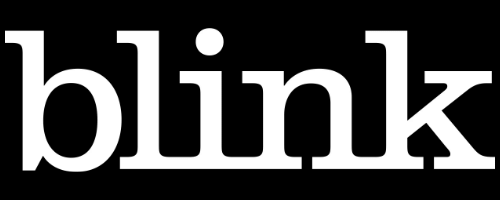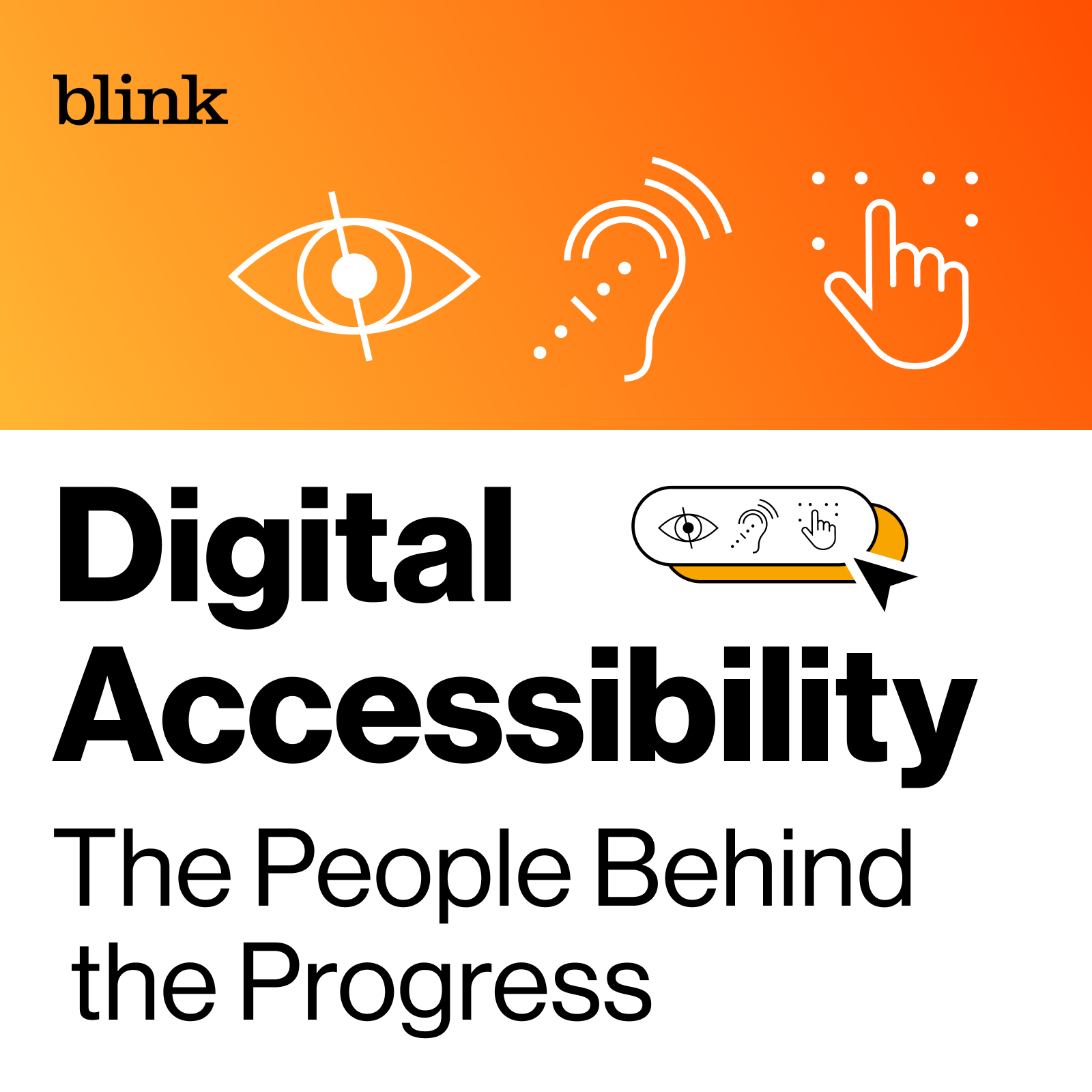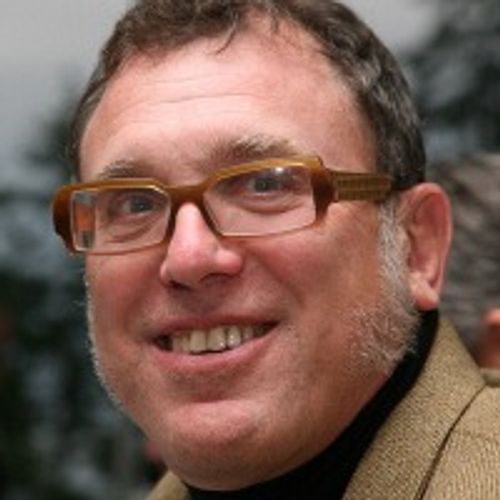Episode 3
Working to Integrate All Abilities Through Design
Betty Troy, Yahoo, Accessibility Specialist
Betty Troy started her career through engineering with an emphasis on biomedical programs. That led to specializing in rehabilitation engineering and a position designing physical assistive technology devices for the U.S. Dept. of Veterans Affairs. She further developed her skills as an accessibility auditor at Applause. Now she is an accessibility specialist Yahoo with a focus on user studies.
Mentioned in this episode:
Info about Accessibility at Blink
Transcript
(thrilling music)
Speaker:- Hello, this is Digital Accessibility,
Speaker:The People Behind the Progress.
Speaker:I'm Joe Wilinski the creator and host of this series.
Speaker:And as an accessibility professional myself,
Speaker:I find it very interesting as to how others have found
Speaker:their way into this profession.
Speaker:So let's meet one of those people right now
Speaker:and hear about their journey.
Speaker:- All right. Well, here we go
Speaker:with another episode where I have the interesting
Speaker:activity of talking with an accessibility practitioner.
Speaker:And today I am talking with Betty Troy.
Speaker:Hello, Betty. How are you doing today?
Speaker:- Hi Joe. I'm doing great, thank you.
Speaker:- Well, I am talking from my home office on Vashon Island,
Speaker:which is near Blink's Seattle-based headquarters.
Speaker:Where are you talking to us from?
Speaker:- I'm talking to you from the San Francisco Bay area,
Speaker:and probably the biggest city that most people would know
Speaker:that I'm near is San Jose.
Speaker:And then where one of our Yahoo offices is.
Speaker:- Okay, great. Well, it's great to be able to have
Speaker:this opportunity to chat with you.
Speaker:And I know a little bit about your background,
Speaker:but good place to start always with you is just
Speaker:telling us a little bit about the work
Speaker:that you're currently involved in.
Speaker:- Yeah, I'm at Yahoo right now,
Speaker:as an accessibility specialist.
Speaker:And what I'm focusing on a lot right now
Speaker:is doing user studies and understanding the users
Speaker:and just getting to know how users use our products
Speaker:and where some issues are
Speaker:and providing the feedback back to our teams.
Speaker:So that's mainly what I'm focusing on,
Speaker:and measuring the accessibility of our products.
Speaker:So-- and also I'm doing some internal mentoring,
Speaker:which is something that I'm really excited about
Speaker:and passionate about to help spark interest
Speaker:in accessibility in small bites.
Speaker:And that's something I'm very passionate about right now.
Speaker:- All right. Well, great.
Speaker:Well, yeah, I definitely want to learn a little bit more
Speaker:about the things that you're doing at Yahoo
Speaker:and also a little bit more about the mentoring program,
Speaker:because this program is all about helping others
Speaker:find their way into career and accessibility.
Speaker:But one of the things that I also like to do is find out
Speaker:how people made their way to where they are today.
Speaker:And you have a lot of interesting things in your background.
Speaker:Let's go back in time a little bit.
Speaker:Maybe you could let me know when you first started
Speaker:being aware of accessibility and started moving toward that
Speaker:as a career point.
Speaker:- Yeah, so it goes back to my childhood, when I was a kid.
Speaker:And I was a kid who just loved to find solutions.
Speaker:And for example, there was a time when my brothers
Speaker:and cousins and I decided to have an overalls party.
Speaker:And what is an overalls party?
Speaker:It's when everybody wears overalls
Speaker:and gets together and has fun.
Speaker:Well, there were six of us and five of us had overalls,
Speaker:but my little brother didn't have overalls.
Speaker:So that didn't make me feel so good.
Speaker:So I thought about what I could do.
Speaker:So I came up with this design that my mom--
Speaker:My mom actually had some scrap denim fabric around
Speaker:and he had a pair of jeans.
Speaker:So I thought I'd come up with something
Speaker:that could be like overalls for him.
Speaker:So I came up with this design that had a rectangular piece
Speaker:in the front, and it had a waistband and straps
Speaker:that came up from the back and fastened to the front.
Speaker:And inside the waistband had these belt loops in them.
Speaker:So he would wear a regular belt, and his jeans and weave
Speaker:the belt through the loops in his jeans and the loops
Speaker:inside the waistband of this makeshift overall's top.
Speaker:So when he put it on, it looked like pair of overalls.
Speaker:So we were all able to have overalls
Speaker:and have our overalls party and had fun.
Speaker:And I was also a kid who loved to read about physiology
Speaker:and health, and was totally just fascinated about science
Speaker:and the human body.
Speaker:And I would ask my dad to subscribe to things
Speaker:like the Berkeley Health Newsletter
Speaker:and the Harvard Health Newsletter.
Speaker:And while my my classmates were probably reading
Speaker:about romance novels and stuff, I was reading about science.
Speaker:So I decided to go to engineering school,
Speaker:and I wanted something with the human body in it too.
Speaker:And at that time there weren't too many places
Speaker:that offered biomedical engineering.
Speaker:So I made my own engineering major
Speaker:and combined physiology, biology, neurophysiology in
Speaker:with my engineering classes.
Speaker:And so I decided to go to grad school,
Speaker:and there were biomedical engineering programs
Speaker:in grad school.
Speaker:So in grad school, though, I took this really
Speaker:interesting course on assistive technology.
Speaker:And it was taught by an engineer
Speaker:and an occupational therapist.
Speaker:And I thought this was just an amazing course
Speaker:because I was just totally absorbing everything
Speaker:from the course.
Speaker:It's like those times when you are absorbing everything
Speaker:and you hardly take any notes.
Speaker:So I was just really enjoying this course.
Speaker:And there was a project that we had to do.
Speaker:And my project was to create a lap tray
Speaker:for women who had cerebral palsy
Speaker:who used an electric wheelchair.
Speaker:And this was a really amazing project for me
Speaker:because we got to go to the center where she spent her day,
Speaker:and got to see her in her environment,
Speaker:talked to the people who worked with her,
Speaker:looked at her wheelchair, and saw what kind of parameters
Speaker:the design needed to follow.
Speaker:So I created a prom definition and ideated upon that,
Speaker:iterated on prototypes, and then came up with the design.
Speaker:But the golden moment was when the lap tray
Speaker:was placed on her wheelchair and she couldn't speak,
Speaker:but she was making all these happy sounds
Speaker:and waving her arms around.
Speaker:And that was the moment when I knew I could use my skills
Speaker:to help people do what they need and want to do.
Speaker:So I decided to go into rehabilitation engineering,
Speaker:and specialize in that, and created many more of these
Speaker:kind of user-centered designs.
Speaker:And I took a year off for my grad school program
Speaker:and did this assistive technology program
Speaker:in rehabilitation engineering in San Francisco,
Speaker:and which focused very deeply on assistive technology
Speaker:and various types of disabilities.
Speaker:And during that time, I was also an intern
Speaker:at the children's hospital
Speaker:at Stanford Rehabilitation Engineering Center.
Speaker:And I rotated through three different areas,
Speaker:augmentative communication, prosthetics and orthotics,
Speaker:and seating and positioning, and learned a lot of things,
Speaker:got to see a lot of different cases.
Speaker:And during that time, I also entered
Speaker:a student design contest at RESNA,
Speaker:the Rehabilitation Engineering and Assistive Technology
Speaker:Society of North America.
Speaker:And it was a power soccer guard design, and I actually won.
Speaker:So with a project partner, we created this
Speaker:power soccer guard for power soccer players,
Speaker:which I don't know if you've ever seen
Speaker:power soccer being played.
Speaker:But they basically have this big, huge like a big yoga ball
Speaker:and they propel their wheelchairs and compete
Speaker:in a indoor gym.
Speaker:And we made this guard that helped them not get
Speaker:so many injuries or damage to their wheelchair.
Speaker:So after that--
Speaker:- Yeah, can I just jump in for a sec?
Speaker:- [Betty] Yeah.
Speaker:Yeah, well, just wanted to catch up where we're at so far.
Speaker:And so, up until this point, it seems like you had found
Speaker:just a really natural path where everything seemed to
Speaker:link up one after another, through the university setting
Speaker:in academia.
Speaker:At this point, were you thinking that your career
Speaker:was going to continue more in an academic way?
Speaker:Or were you already starting to think that
Speaker:you might be moving into non-academic,
Speaker:other parts of your career?
Speaker:- At this point, I wasn't quite sure yet.
Speaker:I was open to anything that would be coming in my path,
Speaker:the next thing that would be coming.
Speaker:So actually, I went back to grad school after that
Speaker:and finished my master's
Speaker:and did my master's thesis on ergonomics
Speaker:and manual wheelchair users in the office environment.
Speaker:And then from there, I ended up at the Vue in Palo Alto,
Speaker:and was a biomedical engineer there.
Speaker:So that we worked a lot with Stanford.
Speaker:So it was kind of more academia and lots of research.
Speaker:So we did lot of work with the professors
Speaker:and the clinicians at Stanford.
Speaker:And I got to work with some amazing people.
Speaker:When I was at the Vue, I was a biomedical engineer
Speaker:in the human machine integration section,
Speaker:and worked the main project.
Speaker:I did a lot of things there,
Speaker:but the main project that I worked on
Speaker:was the wearable accelerometric motion analysis system,
Speaker:which was a wearable system that used accelerometry
Speaker:to look at the motion signatures of people,
Speaker:particularly in the area where people might be fall-prone.
Speaker:This was to be designed ultimately as a fall prevention aid.
Speaker:So the idea was that these people would wear this device
Speaker:if they were fall prone
Speaker:and they'd be trained to fall safely
Speaker:or to fall with minimizing the injuries
Speaker:that they might sustain, if they have a fall.
Speaker:And so this device would be able to detect that
Speaker:and then it would send out a signal or voice or something
Speaker:to let them know that they might be falling.
Speaker:And so they would be prepared to fall.
Speaker:- Was the idea with these projects that these things
Speaker:would then be put in a form to be manufactured
Speaker:so that they'd be available to people to support
Speaker:those physical challenges?
Speaker:- Yeah, we would develop them and then
Speaker:a company would probably--
Speaker:it would be licensed to a company eventually.
Speaker:So yeah, that was the goal to have it licensed
Speaker:after we developed it.
Speaker:- And then, when did things start to pivot and move
Speaker:to where you were working in private industry?
Speaker:- Well, what happened was I took a break to raise my family.
Speaker:And then during that time I wrote a blog.
Speaker:And to write my blog, I created my own website.
Speaker:And then when I was creating my own website, I realized,
Speaker:"Oh this is kind of fun."
Speaker:So I learned HTML and CSS, and then dabbled in web design
Speaker:for a little bit.
Speaker:While I was doing that I discovered the UX field
Speaker:and realized, well that is very similar.
Speaker:That has a lot of similarities
Speaker:to what I used to do in user-centered design.
Speaker:And so I dabbled in that a little bit.
Speaker:And while I was in that field, I learned about
Speaker:the digital accessibility field.
Speaker:And I was amazed with that
Speaker:because it combined so many things
Speaker:that I had been passionate about for a very long time.
Speaker:And it had my new interest in web design.
Speaker:So it combined the human-centered design
Speaker:and accessibility and web design.
Speaker:So I totally dove right in, talked to everyone that I could
Speaker:who would talk to me, and read anything, attended webinars.
Speaker:And there were some wonderful, wonderful people
Speaker:who were willing to help me too, and talk to me.
Speaker:And this is an amazing field 'cause there's so many people
Speaker:who are really wonderful.
Speaker:Some really great people helped me and talked to me.
Speaker:And I also got my CPACC certification.
Speaker:And then I landed at Applause and was an auditor there,
Speaker:an accessibility auditor, which was an amazing place
Speaker:to learn too, and to really build my skills fast, so--
Speaker:'Cause there was some really great experts
Speaker:and auditors, my fellow auditors,
Speaker:and I worked on 80 different projects there.
Speaker:I mean not projects, products. Products.
Speaker:And I got to see a whole lot of things.
Speaker:I mean, these were products that we exercise on,
Speaker:we watch on TV, talk show hosts, websites,
Speaker:and fast food apps and medical things that we invest with
Speaker:and lots of department stores
Speaker:and lots of different types of products
Speaker:I got to see in a very short time,
Speaker:and with the guidance of experts and fellow auditors too.
Speaker:So I learned very quickly there.
Speaker:I got to see a lot of things.
Speaker:And then now I'm very excited I'm at Yahoo.
Speaker:- And so what's that like?
Speaker:So what's a day in the life, or a week in the life,
Speaker:working as an accessibility practitioner at Yahoo?
Speaker:- Oh, I love it. I love my job at Yahoo.
Speaker:I spend some time with the product teams
Speaker:when they have questions on accessibility,
Speaker:and help them with any questions that they have.
Speaker:I also do a lot of user studies to understand the users
Speaker:and how they use our products,
Speaker:and what kind of issues that they have.
Speaker:And I also do a little bit of mentoring
Speaker:of some of our product team members.
Speaker:And I mean, I just love working with the people at Yahoo,
Speaker:and I feel completely supported in accessibility.
Speaker:There is no resistance to it, I feel.
Speaker:Anybody that approaches us or we approach them
Speaker:with something, there's complete acceptance
Speaker:of the accessibility team there.
Speaker:And anything that we incorporate into the products.
Speaker:- Yeah. It's great to hear.
Speaker:And so kinda looking forward, are there any things
Speaker:either Yahoo that you're excited about
Speaker:looking into the future?
Speaker:Or, more generally, things within the accessibility
Speaker:profession, things that you're hoping will develop
Speaker:of any kind of thoughts looking ahead into the future?
Speaker:- Yeah. WelL, what I hope to see is everything
Speaker:will be integrated.
Speaker:What I hope is that there is some resistance
Speaker:in the field right now, and there is sort of--
Speaker:we're kind of getting used to this.
Speaker:There's a lot more awareness now because of the pandemic,
Speaker:I think, for digital accessibility. But it's more--
Speaker:I hope that there is more of a feeling of us.
Speaker:According to the CDC, there's 26% of us have or adults
Speaker:in the US, have disability at a time.
Speaker:So it's not people with disabilities are in one part
Speaker:of the world or one part of the US,
Speaker:it's we're all integrated.
Speaker:Everybody is mixed together.
Speaker:And it's us that have disabilities.
Speaker:And at some point, we're gonna have disabilities
Speaker:most likely when we age and it's really us.
Speaker:And we create everything that we use, really.
Speaker:It's created by us, and everything we create
Speaker:can be considered as a prototype,
Speaker:and we can decide what to do with what we we create,
Speaker:and what we go forward with with the next prototype.
Speaker:So I hope that we will integrate more,
Speaker:people with disabilities, different abilities,
Speaker:and listen and incorporate that into our designs.
Speaker:So that's what I hope to see in the future.
Speaker:And I think we'll get there, at some point we'll get there.
Speaker:The awareness is starting to get out there
Speaker:and we're working toward it.
Speaker:And it's a big job, and we've had to start somewhere,
Speaker:but we'll get there.
Speaker:- Well, I think that's a great place for us
Speaker:to end this conversation.
Speaker:Betty, thank you so much for telling us
Speaker:about your background and the the wide range of things
Speaker:that you've been involved in.
Speaker:And I look forward to hopefully meeting you
Speaker:in the physical world at some point,
Speaker:at a conference or something like that.
Speaker:- Yeah, that'd be great. It's been a pleasure.
Speaker:- Thanks a lot. Bye-bye.


